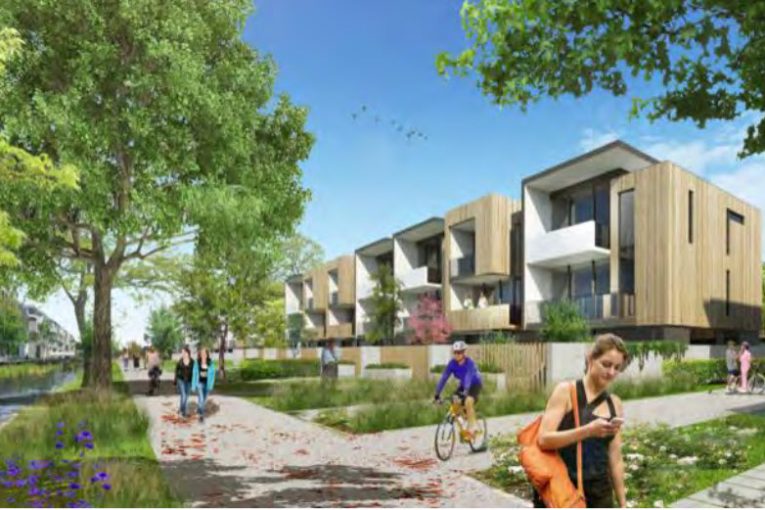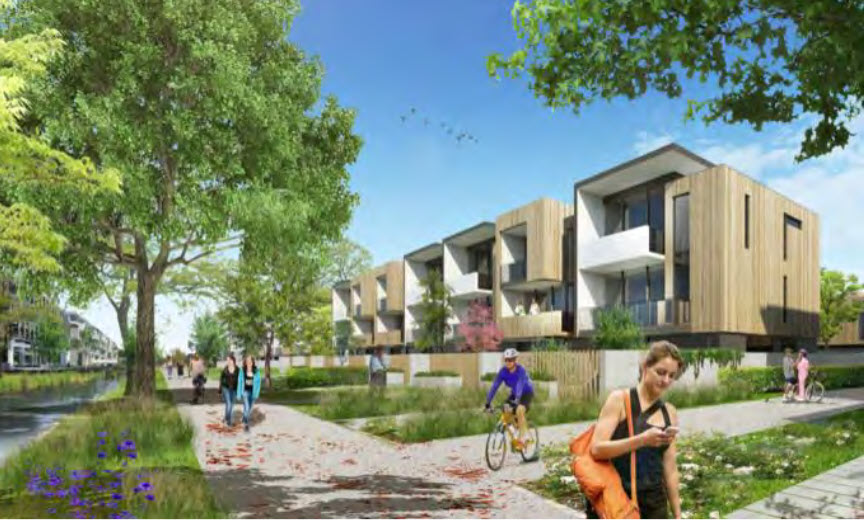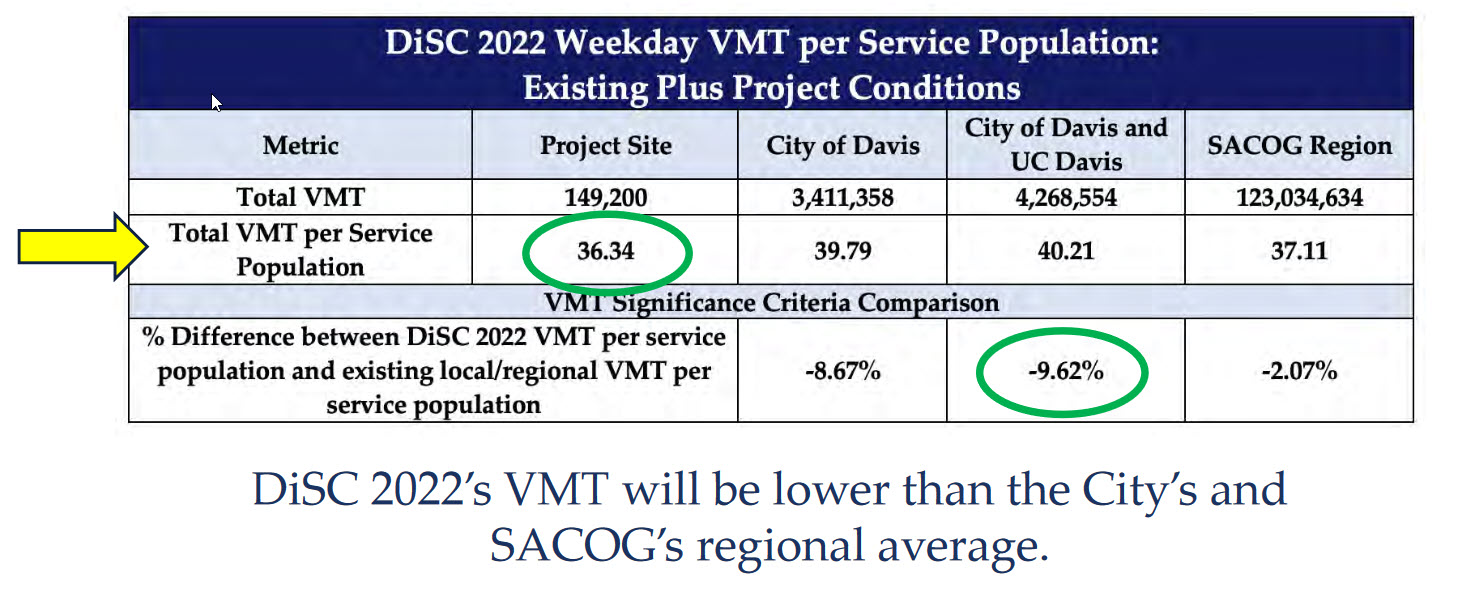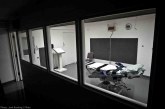

By David M. Greenwald
Executive Editor
Davis, CA – Opponents of the project continue to attempt to make the case that DiSC is making “54 million pounds of new GHG emissions” and ignoring the fact that each of the 4000 or so projected employees at DiSC would be working and driving to another location if DiSC 2022 is not built.
This is not just a Vanguard argument at this point.
Matt Keasling on Tuesday, for example, in responding to some of the criticism of the project, addressed the issue of whether DiSC would add GHG emissions and move away from climate change goals.
Keasling referenced a regional map on VMT (Vehicle Miles Traveled) and said, “Davis, quite frankly has a challenge with VMT. Particularly that if you’re living in Davis and you need to do anything that’s not in the city of Davis, it actually is a pretty long drive to your next location.”
 Because of that, “you tend to have a higher VMT across the board than other jurisdictions, particularly the city and county of Sacramento.
Because of that, “you tend to have a higher VMT across the board than other jurisdictions, particularly the city and county of Sacramento.
“However, what our analysis shows us is that the VMT associated with this project is less than the city’s average. It’s almost 10% less than the city and UC Davis combined VMT average,” Keasling explained. “And so DISC is moving the city in the right direction when it comes to VMT and with our mitigation measures to create a robust TDM [Travel Demand Management], we believe we will achieve the 15% below the regional VMT average at project buildout with our mitigations.”
Now Alan Pryor counters that this analysis “relies on bogus Fehr and Peers calculations showing that the average VMTs (Vehicle Miles Traveled)/Per Capita of Service Population for the SACOG region is 37.11 miles per day.”
Pryor quibbles on the specific SACOG VMT analysis and argues that the SACOG region is substantially lower than the 37 as presented in the Fehr & Peers analysis. He writes, “Higher VMTs associated with the DiSC project directly translate into new higher GHG emissions for the project.”
But the point of the analysis is that even if DiSC does have a higher average VMT than the region, the person commuting to DiSC is not going from zero to 36 VMT. It’s still an offset.
This is the point made by both Will Arnold and Lucas Frerichs on Tuesday.
As Arnold pointed out, “What we have in town, unfortunately still, is a mismatch of jobs and housing.”
He said, “We have a lot of really expensive housing and a lot of low paying jobs other than the university itself, and a handful of other places. We have a mismatch. And what that mismatch causes is it causes a lot more travel. You got to go somewhere else. If you’re going to work a job that allows you to own a home in Davis, you’re hitting the road to get to that job. And so creating jobs, more jobs in Davis that allow you to be living in Davis is a good thing, and will likely have the effect of having fewer people having to travel outside of town for work.”
Lucas Frerichs added, “Some folks view this as a situation where they feel as if we don’t build it, if we don’t build it here, you know, we stop the development, we’ve won, right? But it just gets built somewhere else. That’s the reality. And frankly, with lower standards and lower benefits than what we’ve negotiated with this proposal, and I think that is very important to keep in mind as well.”
These are crucial points that are being missed by the opponents of the project.
Right now, if you live in Davis, unless you happen to work at the university, most likely you are traveling outside of town to get to work. That means at minimum you have to commute to and from places like Sacramento.
On the other hand, most people who work in Davis have to commute from places like Elk Grove and Natomas and the like, because that’s where they can afford to live.
Creating high paying jobs next to housing is an environmentally sustainable option.
If you want to argue that we need more housing on the site or near the site, I probably agree with that point. But unfortunately, that is the downside to the Measure J process—you have to design a proposal that not only makes sense, but can pass a vote. And for too many people, even having 460 units of housing is a step too far.
The second point is this—if DiSC doesn’t get built here, it’s not like the companies that will move to Davis cease to exist. They simply move somewhere else, where people have to commute somewhere else and people have to drive to work somewhere else. It’s not necessarily that there will be a DiSC plopped down in another community, but rather that Company A, if it doesn’t go to Davis, will go somewhere else. All of those impacts are going to happen elsewhere.
If you want to argue that DiSC is going to be less environmentally friendly than its replacement, I think that’s a tough case to make, but my ultimate point is that by arguing that it produces 54 million NEW pounds of GHG each year, you are putting your thumb on the scale and skewing it.







To clarify, it would have been proposed in (or outside) one of the other cities a long time ago, if there was actually a demand for it – other than for housing.
David – I just love it when you attempt to rewrite the conclusions of the EIR (prepared by the City’s presumably expert environmental engineering consultant) with frenetic arm-waving to suit your own “Build, Baby, Build” agenda. Better yet, as justification you use the arguments that it just makes “common sense” and you don’t need “rocket science” to figure it out instead of relying on quantitative analysis.
But, silly me, I am just “quibbling” when I insist that you actually have to use thse things called “laws” and “facts” to properly assess the situation at hand. But instead of doing so you rely on your own interpretation and quote the following 3 members of your unabashededly biased Yes on DiSC posse as technical backup
1) Matt Kiesling – Lawyer front man for Ramos
2) Lucas Frerichs – Councilmember all-in on the project
3) Will Arnold – – Councilmember all-in on the project
Looking at that engineering expertise of that line-up, I don’t see why the City even bothered to write the EIR when they could have just had you 4 arm-chair engineering experts to rewrite reality for us uninformed masses.
Oops…wait a minute…tell me again how many engineering degrees do you and the above three folks have between you? (BTW, I have an MS in Industrial Science Engineering and Environmental Health Sciences from Cal).
So let’s first review what CEQA says – Under CEQA (damg stupid laws!), the EIR must evaluate the project against the “No Project” alternative to determine new project impact and report emissions as such.
So let’s look at the facts there – The figure of 20,000+ metric tons of CO2e emissions from the Existing plus Project Conditions clearly says these are new emissions that would not be produced if the project is not built and, therefore, they are a new Significant and Unavoidable Impacts.
If the conclusions from that officially certified EIR (as approved by both Lucas and Will) were otherwise different, why did it not state that in the EIR. In fact, if both Lucas and Will believe the EIR was deficient but they certified it anyway, that is certainly an abrogation of their sworn responsibitlities to uphold the laws of the State of California.
But you and your (engineering :)) backup team otherwise say that that legally required analysis is incorrect because it is just ” common sense” and you don’t need “rocket science” to know that it will be built somewhere else if not in Davis. But says who besides you and your crack team of real estate market analysts and engineering pros who all happen to be over-the-top project proponents.
But it really doesn’t matter what you say because the EIR says you have to evaluate the emissions against the No Project” alternative and that says that there will be new emissions…the EIRs words, not mine.
Now you otherwise say that since the project will certainly be built elsewhere if not in Davis, then that project will certainly have even more GHG emissions than if it were built in Davis because it won’t have the sustainabilityfeatures that the DiSC 2022 project has. But again, says who? The only justification you use is ambiguous language provided by Kiesling, Frerichs, and Arnold and there is no quantitative analysis anywhere to support your assetions – just “common sense” and your statement that you do not need “rocket science” to figure it out.
Well, I am no rocket scientist but I do know my way around this little thing called “facts” and “arithmatic” and I repeat my own assertion that your claims that the project would have more GHG emissions if built anywhere else are imaginary and contrived and have no quantitative basis.
I know I have promised a more in-depth article on this and I have completed my analysis and just have to write it up. I will do so shortly.
In that article I will prove Fehr and Peers demonstrably inaccruate claims that SACOG regional VMTs = 37.11, are grossly overinflated. As I discussed in response to your Sunday article, SACOG reports Residential and Work VMTs are actually between 20 and 21. I will show that as a result moving the project to the other side of the causeway will reduce total project GHG emissions by an average of over 20%, conservatively.
If you have any other solid data to otherwise support your claims ( and by this I mean actual data and not just arm-waving by your team of “common sense experts”) then by all means please share it and I will also try to address that information in my forthcoming (admittedly long-promised) article.
Alan, having worked on several dozen EIRs and CEQA equivalent project evaluations, I will say the CEQA standard is STUPID, STUPID, STUPID. This why EIRs are so poor at truly informing decision makers about the true environmental impacts of the project. Most importantly, the standard box-checking EIR does not consider regional impacts in any coherent way and uses a truly fraudulent way of considering cumulative impacts. (I tried proposing a more correct method at the firm I was working at on a large multi-county project and it was rejected.) The standard EIR rarely considers the question of whether the identified activity will occur elsewhere. (I did get to add this element into a study on a hydropower relicensing project to assess changes in flow requirements.) So the GHG gross increase in the EIR is a myth and should not be referred to, even if it is “legally” correct, without accounting for the offsets that should be in the “No Project” baseline but aren’t there because this is yet another cookie-cutter EIR.
I have long made the argument that almost all of the development that doesn’t occur in Davis will occur elsewhere, most likely in the region. To ignore population growth and increasing economic activity and to try to pretend the tiny diversion by Davis will somehow change this is not a reasonable premise. The research and development activities that would occur at DISC are most likely to occur somewhere else, most likely with many fewer considerations for sustainability and social accommodations. That should weigh into how we consider this project.
I’ll look forward to your SACOG VMT analysis and that might be the appropriate benchmark, but that’s very different than relying solely what’s in the EIR.
You are dead wrong, regarding this.
The reason this occurs is because communities pursue it.
There are places (even in California) which don’t grow at all.
Again, wrong. California is not growing.
Again, wrong.
Other communities already pursue it.
Ultimately, one can only control that which you have an opportunity to control. That’s why it’s useless to try to control what other communities do, including those within the region. Those locales are already controlled by development activists. And even so, they haven’t been able to make California “grow” (as a whole), lately. And even though California isn’t growing, these communities are accommodating sprawl from the Bay Area exodus, despite the Bay Area being a more “environmentally-friendly”, already-dense locale.
Parts of the Bay Area have been losing population to these sprawling locations, despite Scott Wiener’s efforts.
What is the commercial vacancy rate in the Bay Area? (City-by-city?)
Ultimately, it really is “think globally, act locally”. That’s the only opportunity which exists.
On a broader level, this is also a reason that we can’t stop Russia from invading Ukraine, for example. Or, control population growth in India.
No it occurs because there are resources in a region to be used by companies. Yes, a company that doesn’t move to Davis will probably move to West Sac, Vacaville, Roseville…etc…
Maybe, maybe not. We’ll see as things get back to relatively normal. But one thing that you fail to acknowledge is that despite CA’s current population change…THE SACRAMENTO REGION has experienced explosive population and economic growth. You know…the region that Davis is part of.
Not sure what you’re talking about. The area is going to grow. Those diabolical developers with their not so secret plans for development in the region are not the cause of growth in an area (see earlier reply). In terms of the environment…nobody is controlling anything. But growth here or growth in West Sac…environmentally speaking it’s mostly all the same. It’s not like Davis has a biosphere dome covering it and isolating it environmentally from the rest of the Sacramento region.
Strange, how David frequently notes a choice between “Chicago”, vs. “Davis” in regard to one company’s relocation plans. I had no idea that they were both in the Sacramento region.
What makes you think that a company would want to move from wherever it is to the Sacramento region in the first place? With all the massive expense that entails?
Developers absolutely create growth and sprawl, in areas that go out of their way to welcome it. Such as the Sacramento region. They do everything they can to make it “attractive” for them to do so, including implementing tax breaks for companies that consider it. True “loser” communities fight over Amazon warehouses, for example.
Given that I’m fighting-off several development activists simultaneously on here (but only allowed 5 comments in response), I’ll “see you tomorrow”, for a more complete response. 🙂
I have no idea what this comment means.
California is still a prime area to find a skilled/knowledgeable specialized work force.
The Sac area is still near enough to Silicon Valley.
It doesn’t matter what I think, the economic and population growth his happening.
Ya know, if you keep saying it….that doesn’t make it true. Take it from someone who’s job it was to find new markets for development. The first thing you do is look at current and projected economic and population growth. Areas grow due to economic activity. Developers simply facilitate it. What doesn’t get built in Davis will get built in Woodland or West Sac…etc.. The area is growing and it’s not because of developers.
It means that companies looking to expand or move may look at locales across the country, not just one region. By the way, not all companies are looking to uproot from their current locations. They have to have a reason to go through that massive expense and hassle. Including the loss of employees, who don’t want to move. (Assuming that they can’t telecommute, which is increasingly an option. Which means that companies can locate in cheaper locations throughout the country, even if they’re not necessarily expanding. Or, in a smaller space.) But again, this would not be a decision that they take lightly.
Are you claiming that workers (especially those starting out in a career) don’t move (e.g., to places like Austin)?
What does that have to do with something like DiSC? Is Apple going to build a facility, there? And if they did, what do you think would happen regarding sprawl within commuting distance of DiSC? Including in Davis, itself?
Overall, it’s not. California lost population last year, and the U.S. grew at 0.1% – the slowest since the founding of the nation. In California, it is “shifting” somewhat from areas that are more environmentally-friendly (e.g., the Bay Area), to areas that are willing to accommodate sprawl (such as the Sacramento region). Is that the goal?
https://www.census.gov/library/stories/2021/12/us-population-grew-in-2021-slowest-rate-since-founding-of-the-nation.
html#:~:text=U.S.%20Population%20Grew%200.1%25%20in,Since%20Founding%20of%20the%20Nation&text=A%20.,organization%20in%20the%20United%20States.
Economic activity doesn’t just “happen”. It’s pursued (e.g., by many cities). It’s a decision that’s made.
But I see your point, regarding developers not “causing” it. For example, developers don’t propose it in cities that have no interest in it. (I’m referring to both housing and commercial pursuits.)
The Woodland facility still has no commercial tenants (the development that failed in Davis, and adding 1,600 homes in the process).
West Sacramento is a highly-industrialized city, and one with cheap rents. It’s also adjacent to Sacramento. New developments in Davis (in particular) cannot offer those things under any circumstances.
Who cares what the region is doing? That’s the problem in the first place.
Have you seen the result of that (e.g., the residential sprawl, loss of farmland and open space, and traffic occurring throughout the region? Is that what you want? And, has this Ponzi scheme been permanently-solving fiscal concerns in cities throughout California?
But you are correct in that developers won’t propose it, if they don’t believe that local officials will welcome it. And in Davis, you already know how the council views it. (And that goes for the subsequent proposals that are arising, as well – including Shriner’s, Palomino Ranch, the “other” half of DiSC – which would likely be a housing proposal, etc.).
If the city wants to grow, I’d suggest keeping it inside the Mace curve. Plenty of space still, there.
But in keeping with the primary subject of the article, Alan P. is obviously correct in that new employees would obviously gravitate toward housing located in somewhat less-expensive locales than Davis, meaning that DiSC would certainly create more commuters than something similar anywhere else in the region. Many of which would not require sacrificing farmland and open space.
The argument that DiSC will provide jobs primarily for those already in Davis is a fabrication. Most people already living in Davis already have careers, and their employers aren’t going to be moving to Davis if DiSC gets built. Assuming that they aren’t retired, etc. Most Davis workers already have careers (e.g., at UCD or Sacramento), and don’t necessarily even work in the same fields that something like DiSC would theoretically provide – if the commercial is even successful in the first place.
Profit from housing is what’s driving DiSC, and the development in Woodland.
The argument that DiSC will provide jobs primarily for those already in Davis is a fabrication. Most people already living in Davis already have careers, and their employers aren’t going to be moving to Davis if DiSC gets built.
This is just another demonstration of how limited your world actually is. When I graduated from UC Davis, I would have loved to get a job at a company that a place like DISC housed. Upon graduation, I would have gone from the university in my apartment in Davis to a job at DISC. Given that UC Davis has one of the highest percentage of STEM students in the world, I am not an outlier. But you don’t think in those terms. You don’t think from the perspective of a just graduated student or that the reason companies want to move here is for one of the most educated workforces in the country. That’s why your analysis falls short, your incapability of thinking outside of your narrow little box.
Is that right? You’re a “scientist”, working in a lab? One of the labs that reportedly can’t find a home in the entire region?
And if you wanted to subsequently purchase a house (and or live in a more spacious, cheaper unit), your envisioned “DiSC salary” would enable you to do that, in Davis? What’s the starting salary at DiSC, by the way? And you would limit your search, to that locale?
You wouldn’t look for jobs elsewhere, because you’d be so enamored of DiSC and Davis?
Your comments actually support my comments. If the commercial at DiSC was actually successful, it would primarily attract new residents, not those who are already established in Davis.
I guess the argument is that those new residents (new grads) will pay the city’s fiscal bills? (Probably not, when you add in the cost of the resulting sprawl and traffic.) Regardless, it’s nice of you to offer that.
There’s no reason to believe that DISC would be built “somewhere else” in the first place, if it fails in Davis.
If there was such a demand for it, the “approve anything and everything” cities surrounding Davis would have been approached (and approved of) such a development a long time ago.
And not just “one”, as implied. There’d be “innovation centers” every 1,000 feet, alongside the freeway.
Housing is what’s motivating the developer, both in Davis and Woodland. (The latter having failed in Davis on its own, before moving to Woodland and adding 1,600 homes.)
Oh, and what “replaced” the failed development in Davis? Housing, of course (Bretton Woods).
Good thing that they got rid of that pesky “innovation center” requirement at Nishi, as well. At least they were honest about it, as were the owners of The Cannery.
It was rejected by the voters.
The “innovation center” part wasn’t rejected. That was a subsequent developer decision. (And as David reported at the time, UCD also didn’t want that type of development there – regarding access to it through their land instead of via Richards.)
The voters rejected the connection to Richards, primarily.
Of course, some claimed that they initially included the commercial to avoid Affordable housing requirements, in the first place.
There’s no reason to believe that DISC would be built “somewhere else” in the first place, if it fails in Davis.
Correct, I wouldn’t expect DiSC to build elsewhere
If there was such a demand for it, the “approve anything and everything” cities surrounding Davis would have been approached (and approved of) such a development a long time ago.
You mean like in Sacramento, West Sacramento, Woodland, Dixon and Vacaville? They have. The huge company that just moved into Vacaville said that they wanted to be close to UC Davis.
Strange, I’m not familiar with one in Sacramento, other than that heavily-subsidized, 8-acre first phase of Aggie Square.
Nor am I familiar with one that exists in Dixon. Does it include housing? Is it on a site that’s already zoned for commercial? And if so, for how long?
Why still no announced commercial tenants at the proposal in Woodland, years after failing in Davis? Even WITH 1,600 homes added during that 7-mile move up Highway 113.
Why didn’t they build them years ago? No “innovation” at that time? Or, are they really just business parks, under another name?
Seems to me that Vacaville isn’t that close to Davis. Really? Vacaville is as “close” as they can get?
I do know that Vacaville has experienced some other large-scale commercial exodus, a few years back (in that same general area). I can probably look up the name of that failure, if you’d like.
What happens when a community starts depending-upon tax money, for businesses which then fail? Or, fail to materialize in the first place, while spending money on ladder trucks and staffing?
By the way, what do you think of the cancerous sprawl, spreading up Highway 505?
Or, the following? Are you a big fan of Vacaville’s pursuit of sprawl?
https://www.thereporter.com/2021/10/13/city-heralds-start-of-lagoon-valley-development-construction/
By the way, what (exactly) is “lab space”, in terms of the requirements that would supposedly apply at DiSC? The lab space I’m familiar with (e.g., at the non-profit AgStart) required multiple subsidies to be viable. Does someone from the city come in afterward, and say, “yeap – that qualifies as planet-saving “lab” space”?
Dude, you’re grasping at straws….going from the Vacaville’s bio tech center to random comments about sprawl and retail exodus (which is pretty much most big box and chain retail).
The Sacramento region is exploding with economic growth. Your comments about developers creating that growth is just wrong. Developers FOLLOW growth. They build where there is growth or where there will be growth.
You’ve never heard of the Railyards in Sacramento?
I have – they’ve been trying to develop that for years.
Are they calling it an “innovation center”, now? That’s what I’d suggest they call it, at least.
Maybe they can save the planet, there?
Oh – and how about ARCO arena? Weren’t they (at one time) trying to save the planet there, as well? (Last I heard, the school district was acquiring a portion of it. Probably because they didn’t adequately plan for it in Natomas, earlier.)
I also heard talk of moving the Sacramento Zoo there, but I guess that’s off. Then again, I think of Natomas as kind of a “zoo” in terms of traffic and planning, already. (Probably more like an aquarium, if/when the levees fail.)
The 5 comment rule is in effect on this thread.